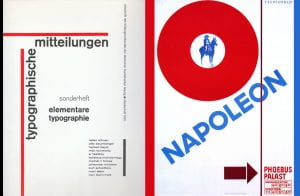Modernism
This week’s class taught about Modernism, which was a period of art that began in the 20th Century, after the end of the First World War. It was made up of a number of key definitive features:
- Reject traditional forms and decorative elements
- Seek a solution that is simple and direct
- Use systematic methods rather than intuitive ones
- Think about relationships in form and content
- Use geometric shapes: circle, triangle, square
- Use primary colours
- Use sans-serif typefaces
- Show contrast in typographical material
- Use photographs and photomontage rather than drawings or illustrations
- Use silhouetted photographs with white backgrounds
- Use maps and diagrams
- Use graphic symbols and icons
- Use of asymmetric page layout
- Use of grid or clearly delineated page-organising method
- Apply a planned visual hierarchy
The core of Modernism was the idea that the world must be fundamentally rethought, and the belief that society could be healed by new approaches to art and design. Artists and designers set out to reinvent the way people lived their lives through the use of design by focusing on elements of everyday life, such as housing, furniture, goods and clothes.
Jan Tschichold
Jan Tschichold, born in 1902, was a calligrapher, typographer and book designer. He played a significant role in the development of graphic design in the 20th century – first, by developing and promoting principles of typographic modernism, and then idealising conservative typographic structures.
Degenerate Art
In July 1937 came the first two exhibitions of Degenerate Art. The first was titled The Great German Art Exhibtion, and was designed to show off works of art that Hitler approved of, mostly made up of depicting blonde nudes, along with soldiers and landscapes. The second exhibition showed the other side of German art, which the Nazis called, “degenerate.” They described it as non-representational, modern and abstract, and any artists, designers or musicians who did not conform to Hitler’s ideals were persecuted.
The exhibition was laid out with the deliberate intention of a negative reaction from the public. Works were included if they were abstract, expressionist, or, as the handbook described, “corruptive.” There were even certain cases where work was included just because it was by a Jewish artist. The exhibition was made to feel anti-modern and as an insult to the artists, with graffiti deliberately being painted over the walls, and the pictures and canvases hung askew.
Nazi persecution forced numerous artists, architects and designers to flee Europe for the safety of distant shores, with many moving to the US, where the new, creative community was welcomed. Eventually came the Ulm School of Design, which sought to restore artistic balance in Europe, and the school went on to quickly become one of the finest and reputable schools of design in the world, alongside the Bauhaus.

